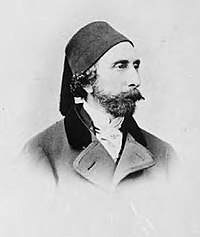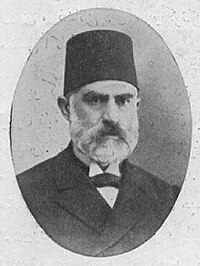Liberalism in Turkey
This article needs additional citations for verification. (September 2008) |
| Part of a series on |
| Liberalism |
|---|
 |
Liberalism was introduced in the Ottoman Empire during the Tanzimat period of reformation.
History

On 30 May 1876,
Constitutional era
Constitutionalism was introduced in the Ottoman Empire by liberal intellectuals like Beşir Fuad, Hekim Ismail Pasha, and Ahmed Zühdü Pasha, who tried to modernize their society by promoting development, progress, and liberal values.[5]

Tanzimât
The
The Tanzimât reforms began under
Young Ottomans
The Young Ottomans were a secret society established in 1865 by a group of Ottoman Turkish intellectuals who were dissatisfied with the Tanzimat reforms in the Ottoman Empire, which they believed did not go far enough, and wanted to end the autocracy in the empire.[18][19] Young Ottomans sought to transform Ottoman society by preserving the empire and modernizing along the European tradition of adopting a constitutional government.[20] Though the Young Ottomans were frequently in disagreement ideologically, they all agreed that the new constitutional government should continue to be somewhat rooted in Islam to emphasize "the continuing and essential validity of Islam as the basis of Ottoman political culture."[21] However, they sincreticize Islamic idealism with modern liberalism and parliamentary democracy, to them the European parliamentary liberalism was a model to follow, in accordance with the tenets of Islam and "attempted to reconcile Islamic concepts of government with the ideas of Montesquieu, Danton, Rousseau, and contemporary European Scholars and statesmen."[22][23][24] Namık Kemal, who was influential in the formation of the society, admired the constitution of the French Third Republic, he summed up the Young Ottomans' political ideals as "the sovereignty of the nation, the separation of powers, the responsibility of officials, personal freedom, equality, freedom of thought, freedom of press, freedom of association, enjoyment of property, sanctity of the home".[22][23][24] The Young Ottomans believed that one of the principal reasons for the decline of the empire was abandoning Islamic principles in favor of imitating European modernity with unadvised compromises to both and they sought to unite the two in a way that they believed would best serve the interests of the state and its people.[25] They sought to revitalize the empire by incorporating certain Europeans models of government, while still retaining the Islamic foundations the empire was founded on.[26] Among the prominent members of this society were writers and publicists such as İbrahim Şinasi, Namık Kemal, Ali Suavi, Ziya Pasha, and Agah Efendi.
In 1876, the Young Ottomans had their defining moment when Sultan
Freedom and Accord Party

- 1911: As a reaction to dictatorial tendencies, the liberal Freedom and Accord Party (Hürriyet ve İtilaf Fırkası) is founded.
- 1913: The party is banned.
Ottoman Liberal People's Party / Freedom Party
- 1918: Fethi Okyar founded in 1918 the Ottoman Liberal People's Party (Osmanlı Hürriyetperver Avam Fırkası).
- 1920: The party disappeared.
- 1930: In an attempt to allow a legal opposition party, Atatürk encouraged Okyar to found the Freedom Party (Hürriyet Fırkası), also rendered as Liberal Republican Party(Serbest Cumhuriyet Fırkası).
- 1930: The party attracted huge number of dissident people of the Kemalist bureaucracy's harsh policies. The founder of the party, Okyar, dissolved his own party, fearing that it was becoming a rallying ground for counter-reformists against the secular republic.
Freedom Party
- 1956: A liberal faction of the Democratic Party founded the Liberty Party (Hürriyet Partisi).
- 1958: The party merged into the Republican People's Party.
New Turkey Party
- 1961: A moderate faction of the former Democratic Party established after the ban of the latter party the New Turkey Party (Yeni Türkiye Partisi).
- 1973: After initial success the party became unsuccessful and is dissolved.
Liberal Democratic Party
- 1994: Founded on July 26 as Liberal Party by former (Demokrat Parti) members and Besim Tibuk, the first president.
- 1996: The Liberal Party changed its name to Liberal Democratic Party.
- 2002: Tibuk resigns as president on November 25.
- 2005: Cem Toker gets elected as president on July 20.
- 2017: Toker resigns as president on January 29. Gültekin Tırpancı gets elected as president on the same day.
See also
- Secularism in Turkey
- White Turks
- Kemalism
- History of Turkey
- Politics of Turkey
- List of political parties in Turkey
References
- ISBN 0313307083. Retrieved 6 May 2017.
- ^ ISBN 0812006372. Retrieved 6 May 2017.
- ISBN 978-1317871071. Retrieved 6 May 2017.
- ^ a b Palmer, Alan. The Decline and Fall of the Ottoman Empire, 1992. Page 141–143.
- ISBN 978-1317696162. Retrieved 6 May 2017.
- ^ Cleveland, William L & Martin Bunton, A History of the Modern Middle East: 4th Edition, Westview Press: 2009, p. 82.
- ISBN 978-1317696162. Retrieved 6 May 2017.
- ISBN 978-1317871071. Retrieved 6 May 2017.
- ISBN 0195358023. Retrieved 6 May 2017.
- ISBN 3515073094. Retrieved 6 May 2017.
- ISBN 978-90-04-06061-6. Retrieved 9 June 2013.
- ISBN 978-1-84854-785-8. Retrieved 11 June 2013.
- ^ Roderic. H. Davison, Essays in Ottoman and Turkish History, 1774-1923 – The Impact of West, Texas 1990, pp. 115-116.
- ^ The Invention of Tradition as Public Image in the Late Ottoman Empire, 1808 to 1908, Selim Deringil, Comparative Studies in Society and History, Vol. 35, No. 1 (Jan. 1993), pp. 3-29
- ^ a b NTV Tarih Archived 2013-02-12 at the Wayback Machine history magazine, issue of July 2011. "Sultan Abdülmecid: İlklerin Padişahı", pages 46-50. (Turkish)
- ^ a b Cleveland & Bunton, A History of the Modern Middle East, Chapter 5 pg.84 of 4th edition
- ^ "Ahmed Reşat Paşa".
- ISBN 978-9090261089.
- ISBN 978-1780743028. Retrieved 6 May 2017.
- ISBN 0521779332.
- ^ Finkel 2006, p. 475.
- ^ ISBN 978-9633860168. Retrieved 6 May 2017.
- ^ ISBN 978-0748688784. Retrieved 6 May 2017.
- ^ ISBN 0-691-14617-9. p. 104.
- ^ Zürcher 2004, p. 78.
- ^ A History of the Modern Middle East. Cleveland and Buntin p.78
- ^ Finkel 2006, p. 489-490.
